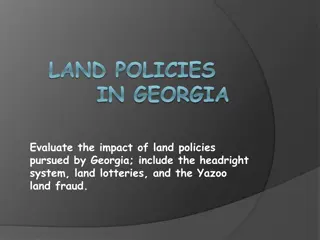Addressing Land Use Conflicts in Wind and Solar Farms: A Comprehensive Analysis
This research paper delves into the complexities surrounding wind and solar farms in Farm County, focusing on land consumption, local opposition, co-location, competing policies, state regulations, and recommended best practices. Issues such as the impact on prime soils, NIMBYism, proximity to communities, environmental and economic impacts, as well as the feasibility of dual-use arrangements are thoroughly examined. The study also highlights the importance of protecting agricultural lands and involving agricultural leaders in renewable energy decision-making processes.
Download Presentation

Please find below an Image/Link to download the presentation.
The content on the website is provided AS IS for your information and personal use only. It may not be sold, licensed, or shared on other websites without obtaining consent from the author.If you encounter any issues during the download, it is possible that the publisher has removed the file from their server.
You are allowed to download the files provided on this website for personal or commercial use, subject to the condition that they are used lawfully. All files are the property of their respective owners.
The content on the website is provided AS IS for your information and personal use only. It may not be sold, licensed, or shared on other websites without obtaining consent from the author.
E N D
Presentation Transcript
Wind and Solar Farms in Farm County: Addressing Land Use Peggy Kirk Hall, Whitney Morgan, and Jesse Richardson Conflicts
Peggy Kirk Hall Ohio State University Agricultural & Resource Law Program Whitney Morgan West Virginia University College of Law Land Use and Sustainable Development Clinic Jesse J. Richardson West Virginia University College of Law Land Use and Sustainable Development Clinic Paper and webinar recording available at: https://nationalaglawcenter.org/webinars/windsolarlandconflicts/
Overview Land Local Opposition State-Local Tensions Co-location Consumption Competing Policies Recommended Practices Resources
Land Consumption Wind and solar land footprint Initial physical footprint Lower power density Time to land use equivalency Lands suitable for siting wind and solar Consequences Competition for land Continuation of struggling farms Prime soils
Local Opposition NIMBYism Proximity Environmental Impacts Economic Impacts
Co-location DUAL USE FEASIBILITY UNUSUAL CO-LOCATIONS
Competing Policies Promote renewables v. protect farmland State v. local regulation Local land use law Preemption
State policies addressing farmland Developers must consider agriculture. Required consultation with state department of agriculture Notice required if project will impact agriculture Impact mitigation agreements or environmental assessments Some also include economic impact on agriculture in assessments
Recommended Best Practices Protect prime soils Involve agricultural leaders in renewable decision-making Planning through mapping Benefits of dual-use or agrivoltaics Planning for decommissioning
What about water quality? Concerns: Impervious surfaces? Infiltration does occur Stormwater management models not adapted to this type of development Little information available on water quality impacts
National Renewable Energy Laboratory Research Project https://www.nrel.gov/solar/ market-research- analysis/pv-smart.html
Peggy Kirk Hall hall.673@osu.edu 614.688.0466 Whitney Morgan whitney.morgan@mail.wvu.edu Jesse J. Richardson jesse.richardson@mail.wvu.edu 304.293.9460























